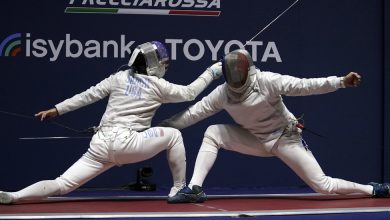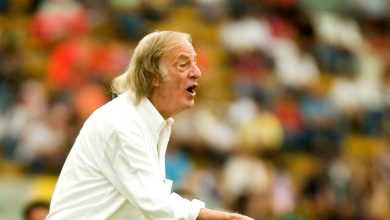Novak Djokovic Comes Full Circle at the Australian Open

MELBOURNE, Australia — It felt like a full-circle occasion as Novak Djokovic celebrated on Sunday in the same city where he had been deported on a Sunday little more than a year ago.
It felt like a cycle was ending. With the Australian Open title and the No. 1 ranking back in his possession, he cried in a way that he had never cried before at Melbourne Park or perhaps at any tournament: with big, loud, body-wrenching sobs as he lay on his back in the players’ box after embracing his family and team and then dropping to the ground, overcome by it all.
When he finally returned to his feet and then to his courtside seat, he buried his face in a white towel and sobbed some more.
“I just felt this huge burden off my back with everything we’ve been through,” he said. “It was a huge relief, and a huge release as well.”
Djokovic has experienced no shortage of powerful sensations in Rod Laver Arena: the coming-of-age giddiness of winning his first Grand Slam singles title in 2008; the sweet misery of winning the longest major singles final in history in 2012 over Rafael Nadal, a 5-hour-53-minute test that left both combatants too weary to stand for the awards ceremony.
But Sunday will surely occupy a category apart. Not for the final itself — a relatively straightforward 6-3, 7-6 (4), 7-6 (5) victory over Stefanos Tsitsipas — but for all that led to it and how Djokovic reacted.
“He’s keeping everything inside,” Goran Ivanisevic, his coach, said. “Sometimes you have to explode.”
Djokovic’s decision not to be vaccinated for the coronavirus has had big consequences, and returning to Australia after his forced exit on the eve of last year’s Australian Open would have been plenty to process on its own. But then came the left hamstring injury that caused Djokovic to hobble at times during the early rounds.
Ivanisevic said “97 percent” of players would have withdrawn from the tournament if they had received magnetic resonance imaging test results that looked like Djokovic’s.
“But not him; he is from other space,” said Ivanesivc, pointing a finger to his temple. “His brain is working different.”
The 2023 Australian Open
The year’s first Grand Slam event runs from Jan. 16 to Jan. 29 in Melbourne.
- Coaching That Feels Like ‘Cheating’: In-match coaching has always happened on the sly, but this year is the first time the Australian Open has allowed players to be coached from the stands.
- Rod Laver Likes What He Sees: At 84 years old, the man with his name on the stadium sits courtside at the Australian Open.
- India’s Superstar: Sania Mirza, who leaves tennis as a sleeping giant, has been a trailblazer nonetheless. “I would like to have a quieter life,” she said.
- Behind the Scenes: A coterie of billionaires, deep-pocketed companies and star players has engaged for months in a high-stakes battle to lead what they view as a once-in-a-generation opportunity to disrupt the sport.
Djokovic, who said he would have withdrawn if this were not a Grand Slam tournament, said he did not practice on any of the off days. He followed the same template in 2021 when he won the title after tearing an abdominal muscle. This time, he also required extensive therapy.
“Look, a lot of people doubted and still doubt that I was injured,” he said, explaining that he would provide evidence at some stage. “But again, I don’t feel I need to prove anything to anyone. But it did affect me, especially in the first week. From the fourth round onwards, I felt like it was behind me.”
Then came the latest controversy sparked by his father, Srdjan, who posed for photos with flag-carrying Russian supporters inside Melbourne Park after Djokovic’s quarterfinal defeat of the Russian Andrey Rublev on Wednesday.
Djokovic explained that his father had intended to celebrate with Serbian fans as he had been doing throughout the tournament. But it was Djokovic who was left to address the incident with tournament officials and to explain it directly to the news media.
“It required an enormous mental energy really to stay present, to stay focused, to take things day by day and really see how far I can go,” Djokovic said.
But it hardly affected the bottom line. He did not lose a set in the semifinal against Tommy Paul, an unseeded American, or in the final against Tsitsipas, the shaggy-haired, 24-year-old Greek star who beat Djokovic in two of their first three matches but has now lost to him 10 times in a row.
On Sunday, Tsitsipas’s best shot, the forehand, too often cracked under Djokovic’s pressure, and sometimes it seemed as if it cracked simply at the prospect of Djokovic’s pressure. But Tsitsipas, who would have become No. 1 for the first time with a first major title, did not look quite as crestfallen as he did after losing a two-set lead to Djokovic in the 2021 French Open final.
“Paris was heartbreaking,” he said.
Instead, whether he realized it or not, he tried to take a page on Sunday night from Djokovic’s early-career playbook: when the Serb was getting beaten repeatedly by more established champions like Roger Federer and Rafael Nadal. Despite the frustration and dejection, Djokovic came to see playing his accomplished rivals as an opportunity to get the most out of himself.
“Novak is a player that pushes you to your limits,” Tsitsipas said. “I don’t see this as a curse. I don’t see this as something, like, annoying. This is very good for the sport, to have competitors like him, to have champions like him. He’s very important for us that want to get to his point one day.”
This seems the smart approach rather than stewing in negativity. But the reality for Tsitsipas is that Djokovic won that first Grand Slam title in 2008 in Melbourne at age 20 and won four more majors before he turned 25. And however full circle it all felt in Melbourne on Sunday night, Djokovic is hardly done searching for more titles, more ways to win.
He and Nadal, who won the Australian Open in Djokovic’s absence last year, are back in a tie with 22 Grand Slam singles titles apiece. Djokovic wants the lead and as many majors as he can get before time and younger men inevitably deprive him of the opportunity.
Like Federer, whose wife Mirka’s support on the home front and on the road with their young children allowed him to compete successfully on tour into his late 30s, Djokovic’s wife, Jelena, is giving him the same flexibility with their young son and daughter. Unvaccinated for the coronavirus, he is still unable to enter the United States at this stage but said he hoped a change in policy would allow him to enter in time to play at Indian Wells, Calif., in March.
“I still have lots of motivation; let’s see how far it takes me,” he said. “I don’t know how many more years I’m going to play or how many more Slams I’m going to play. It depends on various things. It doesn’t depend only on my body.
“I think it’s extremely important for me to first have the support and love from the close ones and the ability to go and play and keep the balance with the private life. But at the same time have the mental clarity or — how should I say — aspirations to really strive to chase these trophies. Physically I can keep myself fit. Of course, 35 is not 25, even though I want to believe it is. But I still feel there is time ahead of me.”
Federer, 41, retired last September, and Nadal, 36, no doubt remains a threat when healthy but is out of action again for at least several weeks, this time with the hip injury that contributed to his losing in the second round to Mackenzie McDonald.
Ivanisevic expects Nadal back in force in the spring for the clay-court season that culminates with the French Open, which Nadal has won a mind-bending 14 times, more than any player has won any Grand Slam tournament.
“What I feel Nadal and I do, what we still fight for and what still motivates us the most is winning the biggest titles in our sport and keeping up with the young guns,” Djokovic said. “I think tennis is in good hands with great characters, great personalities and great players, but we’re still not going anywhere.”
Djokovic has now joined Nadal in the double-digit club at a major tournament with his 10th Australian Open title.
It has been and remains quite a duel, elevating and at times exhausting both men. Chasing excellence is hard enough; chasing it through adversity, whatever its provenance, is harder still.
Though Djokovic, with his supreme timing and elastic movement, can make a difficult game look easy, his emotions in the aftermath on Sunday made it clear how challenging this tournament and this cycle have been. A little more than a year ago, he and Ivanisevic were at Melbourne Airport, being escorted to their plane out of the country.
Now, Djokovic is back on top Down Under.
“I would say this is probably the biggest victory of my life, considering the circumstances,” he said, the Australian Open trophy back in very familiar hands.




